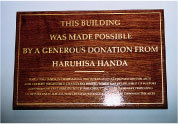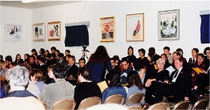半田晴久(深見東州) in ロンドン 1999年11月
ロンドン大学 Royal Holloway HANDA能楽堂 1999年11月11日
観客数:400 人
半能「岩船」 シテ(龍神):深見東州
仕舞「高砂」 深見東州
半田晴久(深見東州)ロンドン大学 演能&書画展
ロンドン大学 Royal Holloway HANDA能楽堂完成式典

半田晴久(深見東州)さんの支援により、ロンドン大学ロイヤル・ホロウェーカレッジに建設されていた海外二番目(一番目はフランス、エックスプロバンスにあります)で、イギリスでは初めての本格演能施設となる《ハンダ能楽堂》がこのほど完成、そのこけら落としとなる演能会が1999年11月11日に開催されました。このカレッジの演劇部は、英国でも屈指のレベルにあると高く評価されています。
完成した能楽堂の壁面には、日本から空輸された半田晴久(深見東州)筆の掛け軸「紅炉一点雪」「一期一会」「喫茶去」「幽玄」「銀河」、そして水彩画「ムー」「レムリア」「琴平」「香取神宮の池」「熊野灘の朝日」「天之橋立」「菅平の雪ダルマ」などが展示され、書画展を兼ねた演能会となりました。半田晴久(深見東州)さんの書画の設営が終わると、まさに会場の気の次元があがり、驚くほどに澄み切った空間に変貌したのでした。準備をしていた現地スタッフからも、驚嘆の声が漏れていたほどです。

この日の番組は、まず、真紅の髪に鮮やかな色彩の衣装をまとい、華麗で躍動的な龍の姿となってシテを舞われた半能「岩船」。そして、水墨画を見るようなシンプルで格調高い仕舞「高砂」が続きます。すばらしいコントラストが織り成され、最後は「付祝言」で締めくくりとなりました。

超満員の聴衆は、世界最高の完成度を誇る舞台芸術といわれる能の迫力と、深く静謐な幽玄の美に、すっかり陶酔の様子でした。千名を越える参加希望者があったところから、招待者だけを選んだはずが、噂をききつけてもぐりこんできた学生たちもいたりして、150名収容のホールは、立ち見もでるほどで、圧倒的な熱気と歓声が渦巻いたのです。
王立盲人協会(RNIB)レッドヒル音楽学校にて

終了後は、完成した能楽堂の寄贈セレモニーに移ります。地元のエガム市長もお迎えし、半田晴久(深見東州)さんへの感謝の辞が刻まれた銘板の除幕式が行われました。日本の伝統芸術のすばらしさを普及して、より優れた日英文化交流と相互理解の推進に尽力したいという半田晴久(深見東州)さんのスピーチに、大きな称賛の喝采が贈られたのです。聴衆のほとんどが初めて能を鑑賞した方々ばかりであり、頬を紅潮させながら「ファンタステイック!」、「アメイジング!」の声、声、声。終了後も、余韻を抑えがたい様子で、感想を語り合い、ワインを手に書画に見入っています。「私はあの絵が好き!」「私はあっち」と、それぞれの好みを語りあってその傍で写真を撮ったり、中には、初めて見た能舞台のスケッチをはじめる人も。
一方、日本人の参加者の方々は、
「日本でも見たことが無かったのに、まさかイギリスで能を生で鑑賞できるなんて……感動しました。すばらしかったです!」(日本語教師を目指している学生)
「本当に美しくて洗練された動作と衣装がすてきでした。エネルギーを注入されたようで、元気になりました」(同カレッジで演劇を学ぶ女子学生)
と興奮気味に語っていました。また、壁に展示された融通無碍、千変万化の筆体で書かれた掛け軸が、すべて同じ半田晴久(深見東州)さんの筆によるものだと知って、「まさか……。全部違う人の作品かと思っていました……」と、信じられないといった表情で絶句している方もいらっしゃいました。
演能を終えられた半田晴久(深見東州)さんは、《岩船》で付けた能面をお持ちになって、歓談されているみなさんの中に入ってゆかれます。興味津々のイギリス人の方々に、ニコニコされながら気さくに面を見せて構造を説明されたり、時には顔に当ててあげたりまでされています。いうまでもなく、能楽師にとって能面は大変神聖で高価なものです。
しかし、この半田晴久(深見東州)さんのご配慮のおかげで、鑑賞はしても遠い存在に思える能楽が、とても身近に感じられて、もっと知りたい、また鑑賞したいという思いが高まったと大好評だったのでした。
こうして、無事、大成功のうちに柿落としの幕を閉じた半田能楽堂で、2001年には、家元とご一緒の正式な演能会が予定されています。

1999年11月10日、半田晴久(深見東州)さんは、世界最古で最大の権威を誇る盲人組織である王立盲人協会の、レッドヒル音楽学校をご訪問されました。この芸術学校は、視覚だけでなくさまざまな心身の障害をもちながら、優れた芸術的才能に恵まれた若者の育成を担っています。
目が不自由であったり、生まれつきの病気や事故で四肢を失っている彼らの演奏は、全く障害を感じさせないばかりか、魂を揺さぶるような深い感動を与えてくれるものでした。ポピュラーからクラシックまで、流れるように自在に紡ぎだされていく美しく澄んだメロディー。そして半田晴久(深見東州)さんは、目の見えない子供に一言二言声をかけ、その子の弾くピアノ伴奏に乗せて「ダニーボーイ」を歌われたのでした。このときその場に同行していたスタッフは、みな感涙を抑えることができなかったといいます。
この学校には、スティービー・ワンダーや、ビートルズの編曲を担当していたジョージ・マーチンなども訪れているそうです。しかし、学校関係者によれば、子供たちの伴奏に乗って、何のためらいもなくその場で即座に歌を披露された人は、半田晴久(深見東州)さんが初めてだったとのこと。先生の分け隔てのない温かいお人柄に触れた、学校側のスタッフや子供たちは大喜び! 一気に場は盛り上がって、子供達(といってもカレッジなので20歳前後)や教師のリクエストによって「オー・ソレ・ミオ」「帰れソレントへ」「ネッスンドルマ」(オペラ「トゥーランドット」より『誰も寝てはならない』のこと)などを次々に半田晴久(深見東州)さんは歌われ、和やかで楽しい雰囲気に包まれたのです。
ブラインドゴルフを皮切りに、1994年のロイヤルアルバートホールでのチャリティーコンサートによる支援など、足掛け7年にわたって地道に継続してきたイギリスでの盲人福祉活動が、いま大きく実を結び、新たなステップを迎えようとしているのでした。
By 夢野洋子 Handa(Fukami)Fan
Handa Noh Theatre
The Noh Stage, built according to traditional design, was a gift to our College in 1991 from the Japan Festival Committee and Mitsubishi Motors Corporation. It signified their appreciation of the College's strong support for an ancient samurai or warrior art which began in the 14th century and is regarded as the oldest unchanged theatre in the world.
In our department, Noh drama is taught at undergraduate and postgraduate level. Our Centre for the Study of Noh Drama
has an excellent collection of beautifully illustrated Noh books, masks, fans, costumes and audio-visual material, gifts from theJapanese Noh Centre in Hosei University, Tokyo, as well as from theGreat Britain Sasakawa and Daiwa Foundations. Since 1991, we have presented numerous Noh performances with the assistance ofProfessor Naohiko Umewaka - a distinguished Noh actor and the great grandson of the man who transmitted the Noh to Fenollosa, Pound and Yeats. Naohiko successfully completed his doctoral studies here and through him we have held workshops, demonstrations and performances which have all served to make this art more accessible to western students. He is one of our Visiting Professors of Drama.
The stage has several distinguishing features: the wood is unvarnished to remind us of the art's purity and sacred origin; there is a pine tree on the back panel which is both a representation of the sacred pine tree in the Kasuga shrine at Nara and the generic God-Tree which serves as a spirit conductor. Noh drama is a mediumistic art and most Noh plays feature restless ghosts who are compelled to return to earth to re-tell their stories in a sacred space. Such a space was originally marked by a tree and four clumps of bamboo at each corner. There are bamboo clumps on the right panel of the stage which is a reminder of the sanctity of the space.
Another distinguishing feature is the unusually long bridgeway which renders the stage asymmetrical. Not only is asymmetry a characteristic of Japanese art but it suggests imbalance and paradox which underpin the Noh art as well as Zen Buddhism - the religion of the samurai warriors which has shaped it. This imbalance is encapsulated in the famous Noh mask regarded as 'the soul of Noh drama' and only worn by the main actor who plays the central character and dominates the whole performance. Rendered virtually blind by the mask, he describes his ordeal as comparable to 'someone walking blindfold on the edge of a cliff'.
Understandably, the lay-out of the stage takes this difficulty into account by assigning fixed positions to the other participants so that the masked actor avoids collision with them. The Chorus (6-8 men) sit on the right and they comment on, or complete, his lines. They enter the stage through the low sliding door on the right (a gesture of humility) and a relic of the samurai tradition of entering a tea-room through a similar low sliding door to partake in a tea ceremony before battle. The stage assistants and musicians are positioned at the rear of the stage, directly in from the painting of the pine tree. So everything in this theatre, from its architecture to its philosophy, content and stylisation, reflects the Zen / samurai ideal of economy and restraint.
The attractive exterior of the Noh studio and the vastly extended Noh auditorium have been made possible by a generous donation from Haruhisa Handa - a Japanese patron of the Arts.
 深見東州(半田晴久)
Dr. Haruhisa Handa
(a.k.a. Toshu Fukami)
非公式ファンサイト
深見東州(半田晴久)
Dr. Haruhisa Handa
(a.k.a. Toshu Fukami)
非公式ファンサイト


























